Don’t Get Swept Away: 6 River Safety Rules You Must Know
Happytoru is reader-supported. When you click and purchase through my links, I may receive a small commission at no extra cost to you. Thank you so much for your support!
You might go to the river in summer, but rivers can be full of dangers!
The WHO reports that there are around 300,000 drowning deaths worldwide each year.
In Japan alone, there were 1,753 water-related accidents in 2024, including 816 deaths or missing persons.
To protect yourself from river accidents, I’m sharing 6 essential river safety rules you must know to avoid drowning—especially in fast-current rivers like those in Japan!

Table of Contents
◆ 6 River Safety Rules
Rule #1: Check the weather forecast
Rule #2: Check the river’s surface
Rule #3: Check the river’s current
Rule #4: Be prepared if you get swept away
Rule #5: Check the depth underwater
Rule #6: Swim to check
◆ Other Safety Tips
- Wear a life jacket
- Don’t BBQ or camp on a sandbank
- If you get swept away, Don’t Swim!
- Don’t jump in to save a drowning person!
◆ Quick Summary
YouTube
Click here to watch the video ↓
目次
3. オーバーフロー(Overflow)を開く
2.1. eSIMのメリット
a
基本情報
使う前にアクティベイトする必要あり
1. 設定を開く
eSIMに対応していない機種もあるため、自分が使用している機種がeSIMに対応しているか確認してから、使用してください。
確認したい方は、こちらを参考にしてください (*他のサイトに移ります) 。
(iPhoneはXR以降が対応するようです。また、購入した国によっても対応機種が異なるようです。)
6 River Safety Rules
Rule #1: Check the weather forecast
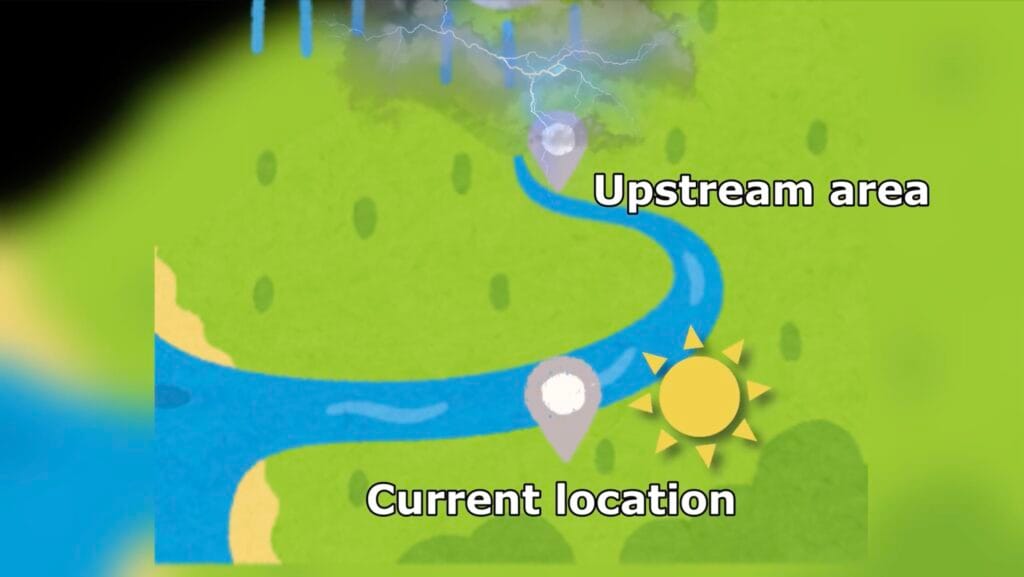
Before heading to the river, always check the weather forecast!
It’s not enough to just check the forecast for the spot where you plan to swim—you also need to check the weather upstream. That’s because even if it isn’t raining where you are, heavy rain upstream can cause the river to suddenly rise.
Also, if it rained the day before, definitely avoid going near the river!
From my own experience, if there wasn’t heavy rain the day before, the upper stream is often not too muddy or swollen. Still, if you really want to stay safe, I recommend swimming in the river only when the weather has been clear for the previous two days and on the day you go to the river.
(These are only general guidelines—always make sure to check the river’s color, flow, and speed with your own eyes.)
Rule #2: Check the river’s surface
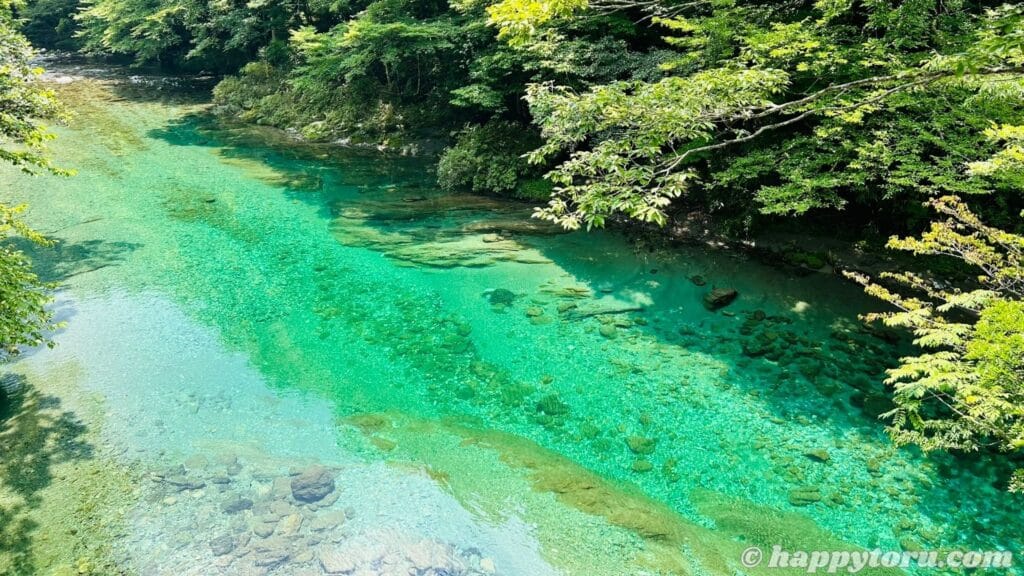
When you get to the river, the first thing you should do is look over the entire area.
At this stage, there are two things to check:
① Depth
First, check the depth.
Look from above to see which areas are shallow and which are deep.
However, keep in mind that the water can often look much shallower than it really is. Until you actually check underwater, treat what you see from above as just a rough estimate.
② Whitewater
Next, check if there’s any whitewater on the river’s surface.
Whitewater—areas where the surface looks foamy or white—usually indicates rocks beneath the surface, irregular currents, or fast-moving water where waves collide.
(The white color is caused by air being trapped and mixed into the water, scattering light and making it appear white.)
Places with whitewater can be extremely dangerous—you could be slammed against rocks or caught in a powerful current that’s hard to escape.
If you see whitewater, do not enter the river!
川の表面を確認
深さの確認:どこが浅いか、どこが深いか
Airalo:グローバル eSIMsの Discover+ がデータ・電話・SMSに対応
Nomad:データ通信のみで、電話プランはありません。(2025年6月現在)
Rule #3: Check the river’s current
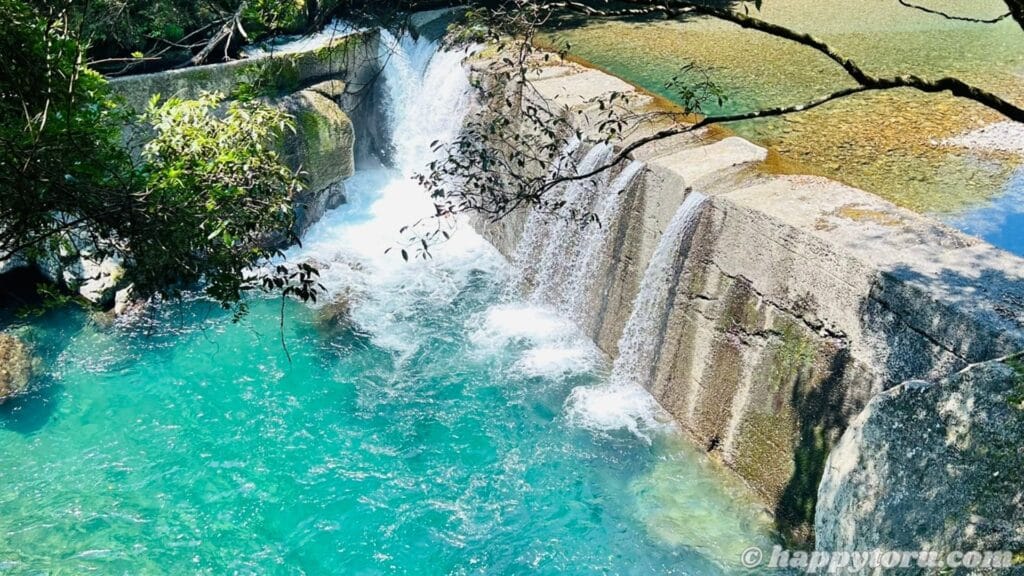
The third point is to “Check the river’s current.”
There are two things you need to look for here!
① Current speed
Look at the surface of the river and observe how fast the water is moving.
As mentioned in Rule #2, check if there is any whitewater on the surface.
Then, try to figure out why that whitewater is there — are they caused by rocks in shallow areas, or by a strong, fast current?
Being able to tell the difference is key to knowing whether the spot is safe to enter or not.

② Backwash and dangerous currents
The most important thing when checking the river’s flow is to look for backwash or other dangerous currents.
Backwash occurs when water swirls violently underwater, creating a very hazardous situation.
It often happens at low head dams or weirs—structures built to block river water—and in plunge pools below waterfalls.
*Photos of backwash underwater, check dams, and waterfall are below.
*Click the photo to enlarge.
If you get caught in a backwash (a powerful recirculating current) near dams, waterfalls, or fast-moving water around rocks, escape is almost impossible.
Even with a life jacket on, you may be unable to surface. Instead, you can be pulled under, spun around endlessly, and eventually drown.
The only possible escape options are:
- Swim sideways to get out of the current.
- Let the current take you down toward the riverbed and try to float up beyond the recirculation zone.
However, you can only make these decisions when your brain is functioning normally — that is, when you’re not panicking.
The more you struggle in panic, the harder it becomes to surface.
If you don’t want to risk your life, stay far away from backwash zones at all costs!
YouTube
See how dangerous backwash is and how to escape it ↓ (Available in Japan)
YouTube
See how dangerous backwash is and how to escape it ↓ (Answer is C)
YouTube
This is the original video ↓
Want to know more about river currents? Visit the BOREAL RIVER RESCUE website for detailed information.
Rule #4: Be prepared if you get swept away
The fourth rule is to imagine what would happen if you got swept away!
There are two key points to keep in mind.
① Find a spot where you can stand
Before entering the river, find a spot where you can stand safely.
If you already know a “safe spot” — a place where you can stand — you’ll be less likely to panic and exhaust yourself trying to fight the current when you get swept away.

② Float and Wait (Uitemate)
When you get swept away, remember this: “Float and wait” or Uitemate in Japanese.
By lying on your back and letting the current carry you, you can save your energy.
However, rivers don’t provide enough buoyancy — only about 2% of your body stays afloat, while you need around 10% to breathe comfortably.
If you can float well, stay on your back and wait for help.
If you can’t, try a gentle backstroke position to keep breathing and conserve energy.
When drifting, keep your feet forward to protect your head from hitting rocks or other obstacles.

Rule #5: Check the depth underwater
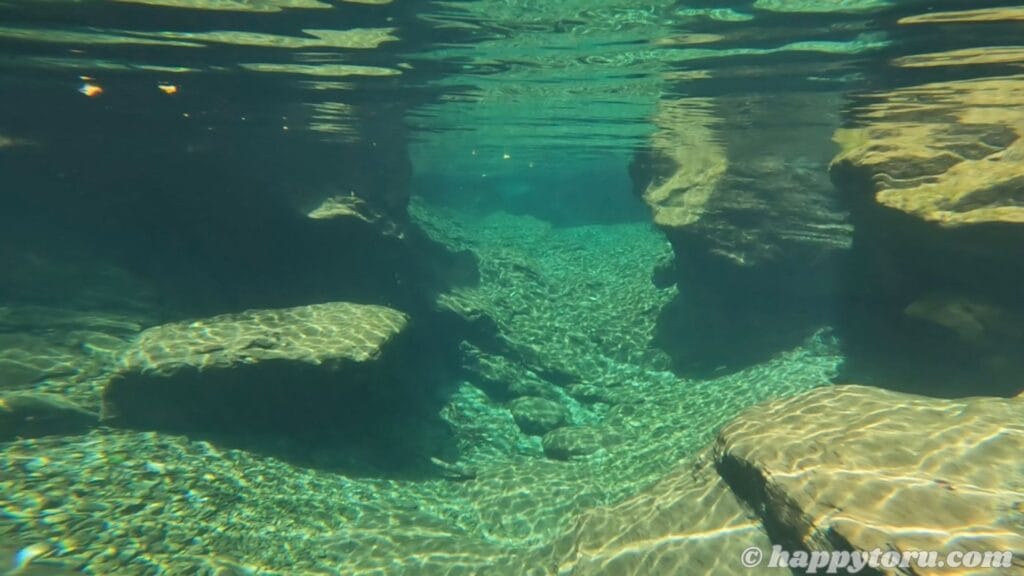
The fifth rule is to check the depth underwater!
When you do, make sure the water is below your waist so you don’t get swept away, and put your face in to check properly.
There are three things you should look for underwater!
① Depth
Looking at the river from the outside can be misleading — it’s hard to judge the depth accurately. That’s why you need to check underwater.
Recheck the spots you observed from the riverbank to see if they are actually shallow or deep. It’s common to find that a spot is deeper than it looks, so always put your face in the water to confirm.
Never jump in without checking first! That’s basically asking to get yourself into danger.
By knowing where the deep spots are, you can stay calm and avoid panicking if the water suddenly gets deep, which makes you much less likely to drown.
② Slopes
After checking the depth, the next step is to check for slopes.
Some spots in the river can suddenly get deep about 1 meter (= 3 ft) after just a few steps. In these areas, the sudden change in depth can trigger panic, increasing the risk of drowning.
To stay calm, you need to check if there are any slopes underwater and observe how steep they are before entering.
③ Rocks’ shape and location
After checking the depth and the slope, the final step is to check the shape and location of rocks.
There are two main benefits to doing this:
- You can jump safely.
- You can rest if you get tired while swimming.
Before jumping, always check the rocks’ location, shape, and water depth to make sure the area is safe.
Checking underwater allows you to see the rocks more accurately.
Knowing where the rocks are also helps you rest during swimming — you can stand or sit on them to recover your energy.

Rule #6: Swim to check
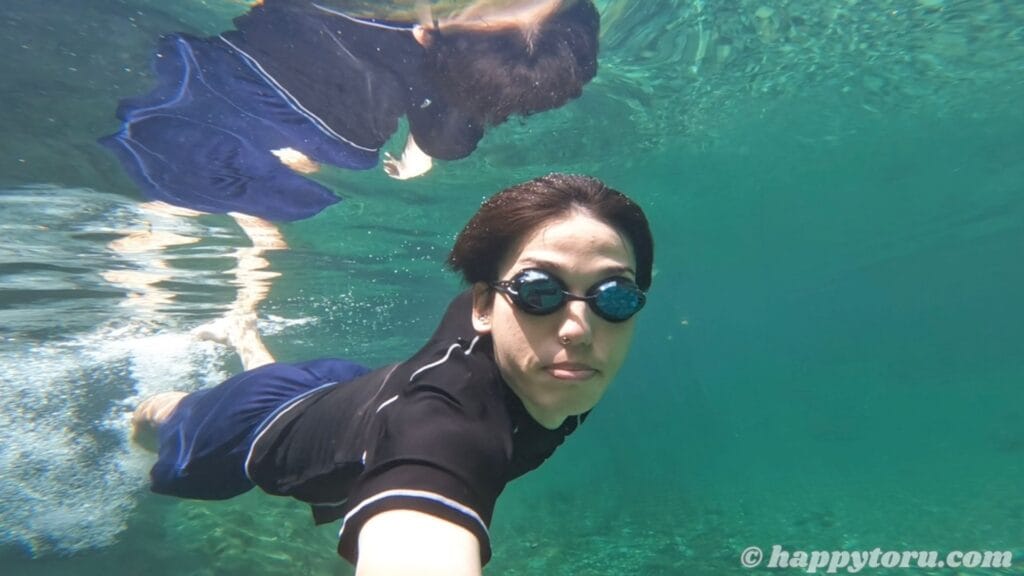
If everything from Rule #1 to #5 checks out, it’s time to test the river by swimming.
This is your first time “actually” swimming in the river!
While swimming, you’ll mainly check:
- The slope of the riverbed
- The current
- How cold the water is
Walk along the slopes to feel how steep they are, and swim in areas with current to get a sense of how fast the water flows.
As you swim, you’ll also get a feel for how cold the water is.
Other Safety Tips
By remembering and following these 6 rules, you can greatly reduce your risk of drowning in a river.
Now, let’s go over 4 more things to keep in mind to stay safe, in addition to the six rules.
Wear a life jacket
Of course, wearing a life jacket is essential to avoid drowning.
In this post, we focused on 6 safety rules you can follow even without a life jacket, but wearing one is still extremely important.
Everyone should wear a life jacket, especially kids, those who jump in without checking, and anyone swimming in fast currents.
Check out this article on BOATERexam.com to learn more about the importance of life jackets. In some countries, wearing a life jacket is legally required.
Don’t BBQ or camp on a sandbank
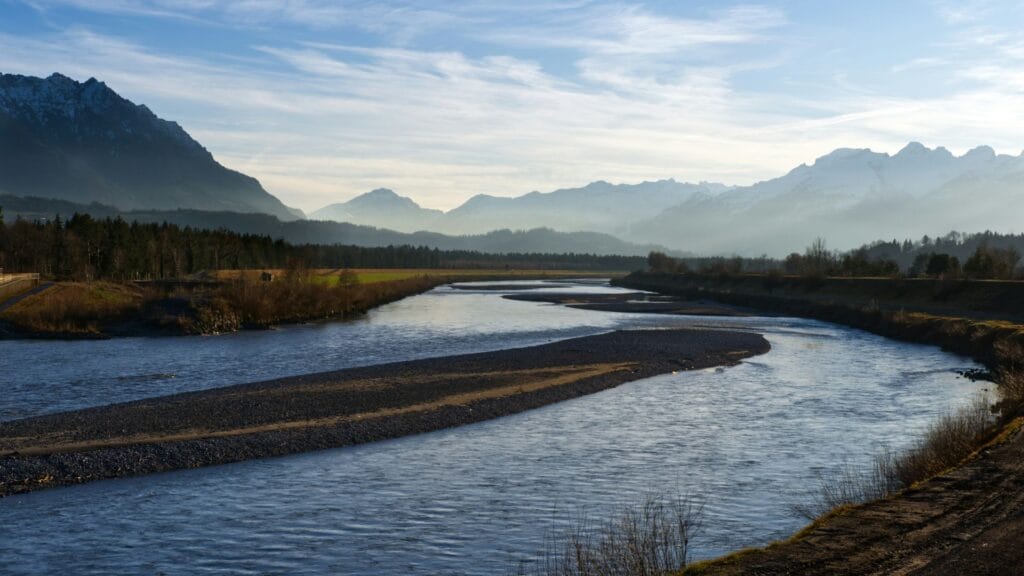
A sandbank is a patch of land formed in the middle of a river by sediment carried downstream.
Some people might think it’s a good spot for BBQ or camping, but it’s actually extremely dangerous!
That’s because areas without vegetation—like bare gravel bars—are places that submerge completely when the water level rises.
If the river swells while you’re camping on a sandbar, it can quickly become impossible to escape, as the area sinks under water.
In fact, in August 1999, a tragic accident occurred at Kurokura River in Kanagawa Prefecture, Japan, where 13 of 18 campers lost their lives after being swept away by rapidly rising water.
(Video at 1:32 – they were at a sandbank, 5:43 – the swollen river sweeps them away)
YouTube
Watch the real footage ↓ (Video is in Japanese)

If you get swept away, Don’t Swim!
When you get swept away, don’t swim frantically!
Stay as calm as possible, keep air in your lungs, and focus on floating.
Panic leads to exhaustion — you’ll lose buoyancy as you exhale, sink deeper, and reduce your chances of rescue.
Save your energy so you can grab a rope or flotation device when help arrives.
Watch this video to see why conserving your energy is so important. (Video is available in Japan)
YouTube
What to do if you get swept away in a river ↓

Don’t jump in to save a drowning person!
It’s one of the most important — yet most difficult — rules to remember:
Don’t jump in to save someone who’s drowning.
If your own child were drowning before your eyes, your instinct would be to dive in immediately.
But approaching a drowning person is extremely dangerous.
Even a small child can pull down an adult.
A drowning person is desperate — struggling for their life.
When they see someone coming to help, they’ll grab on with all their strength — arms, legs, anything.
Imagine this:
You’re trying to swim, but someone is clinging to you.
You’re trying to breathe, but they’re pushing your head underwater, desperate to lift themselves up and take a breath.
The result is almost inevitable:
Both drown… or, if you’re lucky, one survives.
(In the best-case scenario — both survive, but that’s rare.)
And how do I know this? That’s because…

My dad was desperate, shouting, “Let go! Don’t grab me!”
But I was frantic too — just trying to float, breathe, and stay alive — and I clung to him from head to toe.
I even pushed his head down to lift myself up and get a breath!
(Under normal circumstances, you’d never do that to someone, but panic shuts down rational thinking.)
Thankfully, he saved me, but he later said, “I thought I was going to drown too!”
From this experience, I realized: swimming to save someone who’s drowning is basically putting yourself in danger.
Keep in mind: a drowning person may grab you and try to use you as a flotation aid.
In case of an emergency, instead of jumping in yourself, I strongly recommend using a water rescue rope — a much safer way to help!
When someone is drowning, you can simply throw the rope bag from the shore without entering the water, greatly increasing the chances of saving both the drowning person and yourself.
You can purchase one from the link below — it’s a good idea to have one on hand when going to the river.
もしもアフィリエイトで、Amazonと連携ができたら、Pochippを使ってリンクを表示する。
Amazonと楽天はもしも、YahooはValueCommerceから設定する!
PVが安定したら、Geniuslink($9)で、Amazonリンク作る。海外用
Links for those who live in Japan ↓
YouTube
Video of an actual rescue with Water Rescue Throw Bag ↓
eSIM 電話・通話のプラン
Global Yo:国際電話のプランを +$5(約700円)で追加可能
Airalo:グローバル eSIMsの Discover+ がデータ・電話・SMSに対応
Nomad:データ通信のみで、電話プランはありません。(2025年6月現在)
地域別のeSIM
アジア地域のeSIMは、アジアの国で利用可能
何か国も旅行する方にオススメ!
ヨーロッパ、北アメリカ、ラテンアメリカなど多くの地域に対応
Quick Summary
In this post, I covered “6 essential river safety rules to avoid drowning in rivers” and other important safety tips.
Here’s a quick summary: First, the 6 river safety rules!
6 River Safety Rules
1Rule #1: Check the weather forecast
2Rule #2: Check the river’s surface
3Rule #3: Check the river’s current
4Rule #4: Be prepared if you get swept away
5Rule #5: Check the depth underwater
6Rule #6: Swim to check
Now, let’s go over 4 additional safety tips.
Other Safety Tips
1Wear a life jacket
2Don’t BBQ or camp on a sandbank
3If you get swept away, Don’t Swim!
4Don’t jump in to save a drowning person!
Before heading to the river, keep these points in mind and put them into practice.
Simply following these rules can greatly reduce the risk of river accidents.
Share this article with your family and friends so they can also learn more about river safety.
Stay safe, avoid drowning, and enjoy the river to the fullest!

Related Topics
I created my website and started YouTube channels in my senior year of university.
To achieve my life goal: “making many people happy,” I decided to learn how to create a website from scratch through YouTube and the Internet, then launched my own site, “happpytoru.”
I write blogs on various topics: travel, language learning, tips for living a fulfilling life, and more.
Also, I have multiple YouTube channels to share about traveling, languages, and life tips.
【本記事で使用している写真】
UnsplashのOpal Pierceが撮影した写真

Please leave your message!






